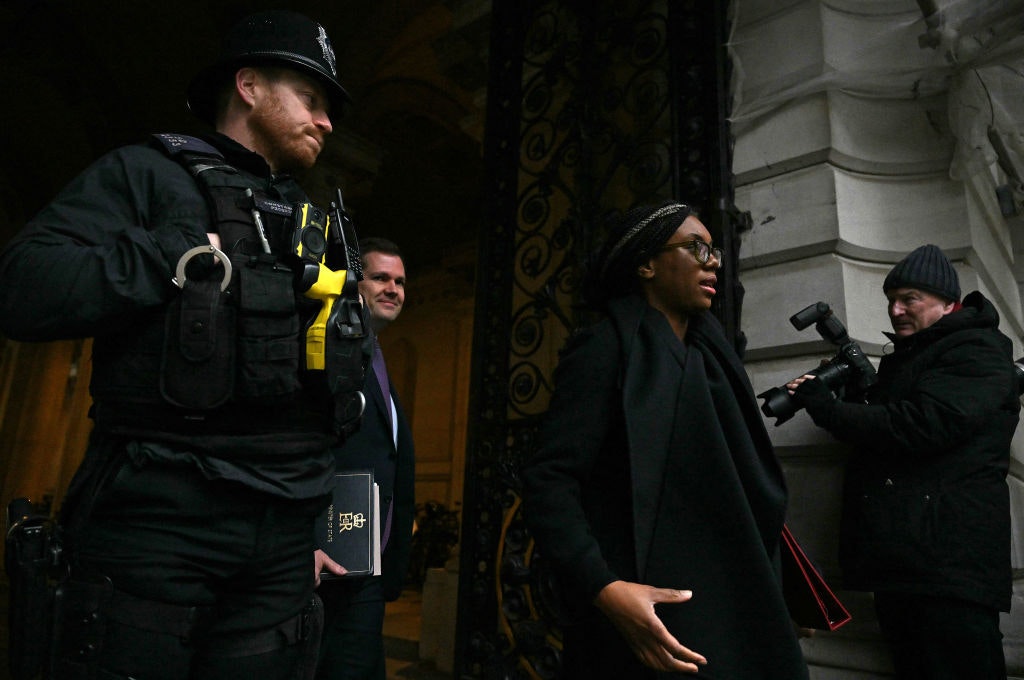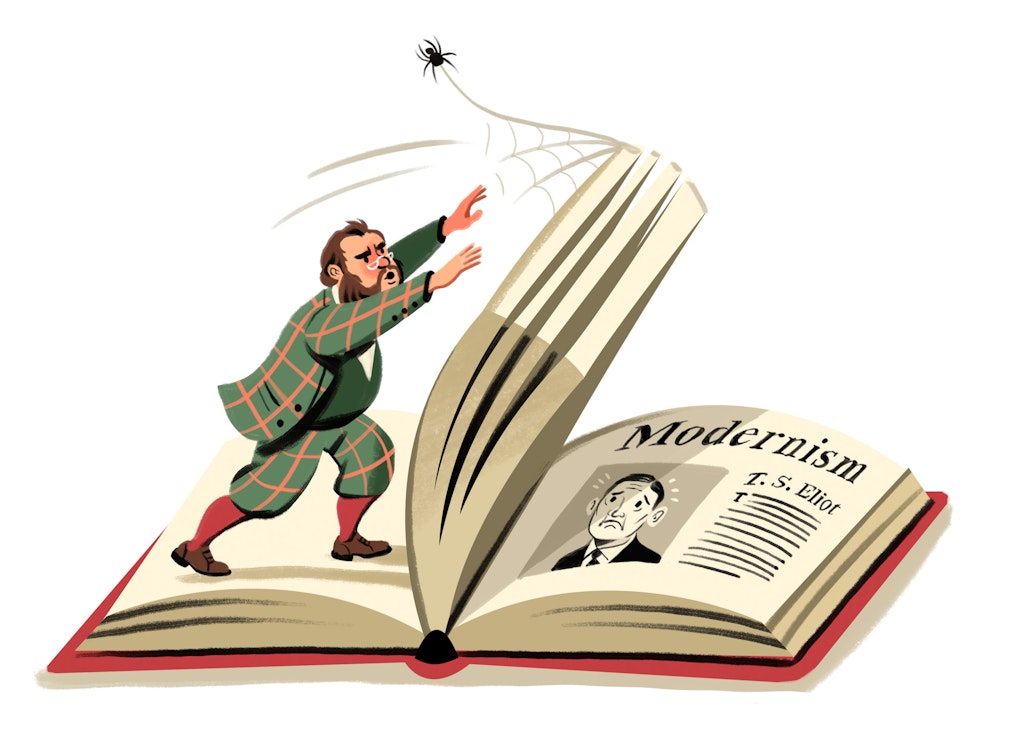Whistler in black and white
A video artwork that aims to critique Rex Whistler’s controversial mural in Tate Britain lacks context and nuance
This article is taken from the July 2024 issue of The Critic. To get the full magazine why not subscribe? Right now we’re offering five issues for just £10.
In 1944, the painter rex whistler was leading a tank crew through Normandy, when he was blown up by a mortar shell. The tank features in Viva Voce, a 22-minute artwork in Tate Britain, made by the black British artist Keith Piper as a critique of the murals with which Whistler covered the walls of the refreshment room when he was a mere 21 years old. Strangely, though, the piece does not reveal that the artist — to his admirers, the epitome of blighted promise — was killed. Instead, it mocks him for wanting to be a hero.

Did Whistler have a hero complex, in the manner of Nelson or General Custer, both of whom had sought glory at all costs since they were boys? It seems unlikely, but that hardly matters. Whether or not Whistler wanted to be a hero, he was one. It’s quite an important point.

Whistler, whose art turned its back on the experiments of Paris — no cubism, no abstraction — to create a world of fantasy and caprice, was near-cancelled four years ago when activists from White Pube noticed that the murals contained what was intended to be a witty reference to slavery. Obviously wit is out of place when addressing such a horrific subject, but attitudes were different in the mid- 1920s. A few square inches of Whistler’s enormous painting show a cartoonish black boy being led on a chain by a pretty girl in crinoline and bonnet while his naked mother shins up a tree to escape. This put the Tate in a fix.
The restaurant — previously a profit centre — was closed, leaving a large space with no rationale. Viva Voce investigates the artist’s intention behind the work — other, of course. than to make a splash in his first major commission.
I’d really like to value this dialogue between a fictionalised Whistler and a modern-day professor, who has poked around in the archives and dredged up as much dirt on the artist as she can find. It’s well made, it’s well acted, it’s an interesting idea. Unfortunately, the approach is that of the magistrate in The Wind in the Willows, who sentences Toad to 20 years for stealing a car and cheeking a rural policeman “without, of course, giving the prisoner the benefit of the doubt, because there isn’t any”.
While gallantry against the Nazis is dismissed as chauvinism, Whistler is equally brought to book for having failed to participate in the General Strike of 1926, the year the mural was commissioned. Quite what would have been achieved by him as a young artist downing tools is not explained. Not liking communism is interpreted as another moral blot.

Whistler was not a profound artist, but he was brilliant and captivating. After the Tate, he went on to create other mural rooms, design stage scenery and costumes, and illustrate numerous books, as well as applying what the Oxford Dictionary of National Biography calls his “astonishing versatility and adaptability” to such varied fields as “textiles, china, carpets, bookplates, letter-headings, and even luggage labels for Imperial Airways”. Only 39 when he was killed, he left a large, mostly enchanting if frivolous oeuvre.
In none of it does Whistler consciously take a stance on race. He was an aesthete, not a blackshirt. Although most of the figures in the story are highly characterised, not least because they are based on Whistler’s friends, the two that now give offence are not portrayed realistically — they look more like puppets or carnival figures. This has been read as casual racism.
Could it not also be taken as an ironic commentary on the carefree figures in the painting? Just as Poussin’s Et in Arcadia Ego reminds us that death was present in Arcadia, so Whistler may be saying Arcadia does not exclude abhorrent cruelties such as enslavement. This is art. Art can be capable of numerous interpretations, sometimes simultaneously.
Let’s remember the context of the times, when British cuisine was at its nadir, and something bright and frivolous was needed by way of décor to take diners’ minds off the food. This suited the Rococo-loving Whistler down to the ground. Later he would be conspicuous for his mastery of trompe-l’oeil.

He was not the only British artist with escapist tastes. Memories of the First World War gave much to escape from. Lyricism and pastoral were not much in vogue in Paris but made a particular appeal to English sensibilities, not only in the work of Eric Ravilious, who also died in the Second World War, but in neo-Georgian poetry and the music of Gerald Finzi. The theme of the Tate murals is an Expedition in Pursuit of Rare Meats, which might be served as an alternative to the unappetising fare encountered in the refreshment rooms of the real world.
To my taste it was all a bit contrived, but contemporaries mostly loved the effervescence and whimsy. As Britain struggled to adjust to the post-war realities, they needed cheering up. Subsequent generations continued to enjoy the work, as it grew darker beneath cigarette smoke and gravy fumes, as an accompaniment to the exceptionally good cellar that — for a time in my youth — was phenomenally well priced. (If only I could have afforded to go there!)
Whistler concocted the story with his devoted older friend, Edith Olivier, but, written down, it was so bad that they could find nobody to publish it during his lifetime. However, in the wake of the Black Lives Matter protests that originated in the United States in 2021, the tea room murals caused a storm in a teacup. A pretty severe if localised storm, since Now Viva Voce plays on two screens in the centre of the room, the rest of which remains in darkness.
Not even when the film ends, before starting again on its endless loop, does the light go up — so visitors cannot actually study the work of art that this exercise is about. Whistler is portrayed as ineffectual and possibly deviant. Did the black boy, although clearly intended to be very young indeed, represent another form of rare meat, asks the outraged professor — probably intended to evoke the contemporary preference of, for example, the homosexual painter Glyn Philpot for black models and presumably partners.

There is no record, however, that this was true of Whistler, whose sexuality may have been ambiguous — although he did marry — but should not cause eyebrows to rise in the age of LGBTQ. The implication that the black child was included because Whistler was a pederast is grotesque.
One line of attack is that Whistler should have had more sympathy for the fate of black people since he must have seen plenty of them. But even today, black people make up only 4 per cent of the British population and before 1945 the figure was far lower than that. Whistler would not have seen troops from the King’s East Africa Rifles, as the professor asserts, because they were based in Africa (the clue is in the name). In the Second World War, their theatres of battle were East Africa, Madagascar and Burma.
There is a long tradition of using “blackamoors”, as they were called, as stock decorative figures, like the caryatids or atlases holding up the cornices of buildings. This now makes people uncomfortable but it was not previously the case. Between the wars, blackamoors were more visible in fashionable London than actual black people.
What Osbert Lancaster called Vogue Regency was a popular style; illustrating it in Homes Sweet Homes, he shows a blackamoor next to a fireplace. If Whistler’s work is to be expunged, a lot else will have to go too. I hesitate to mention the London gallery that still has Nubians on display in its entrance hall. Evelyn Waugh’s portrait of His Imperial Majesty Seth of Azania, which he drew for the frontispiece of Scoop, must be passed over in silence.
The conclusion of Whistler’s fable, according to the printed narrative (published in the 1950s), was to have included the release of the faithful slave: a trope that is unacceptable at a number of levels today. For some reason he did not get round to it. Not that it would have changed things if he had; for the child to be freed into the gluttonous white world of Epicurania would have been another affront to the professor.
If Whistler has nowhere to go in all this, neither, perhaps, does the Tate. Its determination to cast the artist in the worst of all possible lights does not solve their dilemma of what to do with the room once this exhibit is removed in a year’s time. They have a new, unexpected gallery on their hands, forever to be mired by containing Whistler’s compromised murals, which are part of a listed building. Having dug themselves a hole, I fear they’re still digging.
Enjoying The Critic online? It's even better in print
Try five issues of Britain’s most civilised magazine for £10
Subscribe














